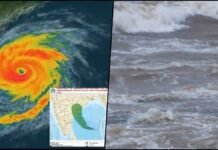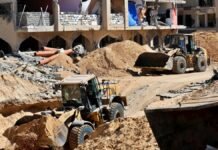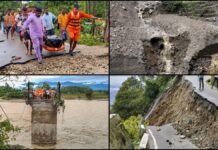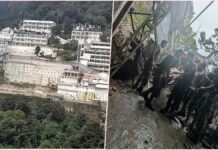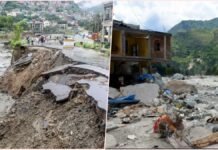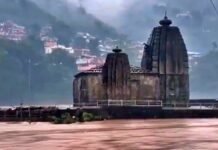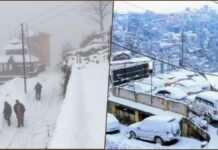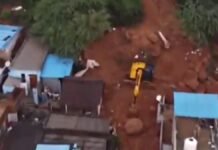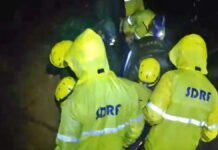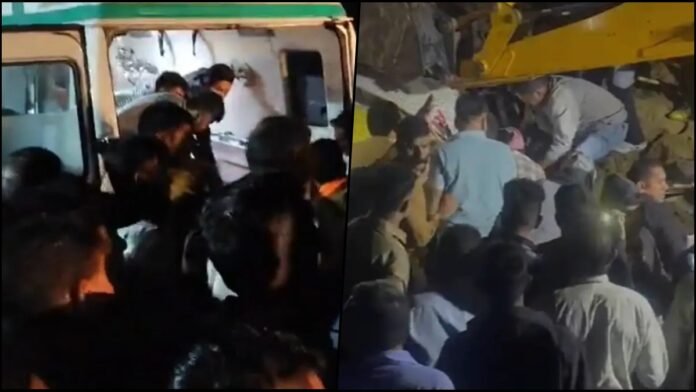
Key Points:
- Private bus “Santoshi” buried under massive landslide near Bhalu Pul and Barthi in Bilaspur district around 6:25 PM
- Approximately 30 passengers traveling from Marotan to Ghumarwin when hillside collapsed
- 12 bodies recovered so far; two children rescued alive from debris
- Heavy rainfall triggers landslide that completely destroyed the bus with falling rocks and debris
- CM Sukhvinder Singh Sukhu directs expedited relief operations, remains in constant contact with district administration
- JCB machines deployed to remove massive debris hampering rescue efforts
- Ambulances and police teams rushed to accident site; injured evacuated to hospitals
- State government pledges full assistance to affected families during tragedy
Bilaspur: A devastating landslide triggered by incessant rainfall in Himachal Pradesh claimed at least 12 lives on Tuesday evening when massive debris buried a private passenger bus in Bilaspur district. The tragedy unfolded near Bhalu Pul and Barthi around 6:25 PM, leaving rescue teams racing against time to extract survivors from under tons of rocks and mud that completely destroyed the vehicle.
Catastrophic Hillside Collapse
The private bus, identified as “Santoshi,” was transporting approximately 30 passengers on the Marotan-Ghumarwin route when disaster struck without warning. Eyewitnesses reported that a large section of the hillside suddenly gave way, sending massive quantities of debris, boulders, and mud cascading down onto the roadway. The bus, which happened to be passing through the vulnerable stretch at that precise moment, bore the full brunt of the landslide.
The sheer force and volume of falling debris completely crushed the vehicle’s roof and structure, trapping passengers inside under tons of earth and rock. The sudden nature of the collapse gave neither the driver nor passengers any opportunity to escape or take evasive action, resulting in this catastrophic loss of life.
Challenging Rescue Operations
Emergency response teams, including local administration officials, police personnel, and disaster management units, rushed to the accident site immediately after receiving distress calls. However, rescue operations have been severely hampered by the enormous quantity of debris covering the bus. The unstable hillside and continued threat of additional landslides have further complicated efforts to reach trapped passengers.
Heavy earth-moving equipment, including JCB machines, has been deployed to carefully remove debris while minimizing risk to any survivors who might still be trapped inside the mangled vehicle. Rescue workers are proceeding with extreme caution, aware that hasty removal of debris could cause further structural collapse or endanger anyone still alive beneath the rubble.
Ambulances have been stationed at the scene to immediately transport injured survivors and recovered bodies to nearby medical facilities. The remote location and narrow mountain roads have added logistical challenges to the rescue operation, delaying the arrival of some emergency equipment and medical supplies.
Death Toll and Survivors
According to the latest reports, rescue teams have recovered 12 bodies from the debris-covered bus. The grim task of body recovery continues as workers systematically remove layers of earth and rock. Medical teams on site have been examining each recovered victim while maintaining dignified handling of remains for eventual handover to grieving families.
In a miraculous development amid the tragedy, two children were pulled alive from the wreckage. These young survivors have been rushed to hospitals for urgent medical treatment. Their condition and extent of injuries have not been officially disclosed, though rescuers remain hopeful that their youth and resilience may aid recovery.
The exact number of injured passengers remains unclear as rescue operations continue. Some victims may have sustained injuries but managed to escape the bus before being buried, while others trapped inside may still be awaiting extraction. Authorities have not yet confirmed whether all 30 reported passengers have been accounted for, raising fears that the death toll could rise as operations progress through the night.
बिलासपुर बस हादसा: स्थानीय मीडिया के अनुसार अब तक 10 से अधिक शव निकाले जा चुके हैं जबकि 2 बच्चों को जीवित निकाल लिया गया है। बचाव कार्य अभी भी जारी है। #HimachalPradesh #bilaspurbusaccident pic.twitter.com/q1IPy3yqqO
— Arpit shukla ✍🏽 (@JournoArpit) October 7, 2025
Chief Minister’s Response
Himachal Pradesh Chief Minister Sukhvinder Singh Sukhu expressed profound grief over the tragedy and immediately directed district authorities to intensify relief and rescue operations. Speaking from the state capital Shimla, the Chief Minister conveyed heartfelt condolences to families of the deceased and offered prayers for the departed souls.
CM Sukhu emphasized that the state government stands firmly with affected families during this devastating period and has pledged to provide all possible assistance, including compensation and support for medical treatment of survivors. He assured that no effort would be spared in rescue operations and that the administration had been mobilized to respond with maximum efficiency.
The Chief Minister has maintained constant communication with Bilaspur district administration officials throughout the evening, receiving regular updates on rescue progress and issuing directives to ensure adequate resources reach the accident site. He has specifically ordered that injured victims receive immediate evacuation to well-equipped hospitals with arrangements for comprehensive medical treatment regardless of cost.
CM Sukhu is personally monitoring the evolving situation from Shimla, coordinating state-level response and ensuring that all government machinery remains focused on rescue efforts and family assistance.
Weather-Related Disasters in Himachal
This tragic incident adds to the mounting toll of weather-related disasters that have plagued Himachal Pradesh during the current monsoon season. The state’s mountainous terrain, while scenic and ecologically valuable, becomes extremely vulnerable during heavy rainfall periods. Landslides, cloudbursts, and flash floods regularly claim lives and disrupt transportation across the region.
Bilaspur district, situated in the state’s central region, features numerous steep hillsides along roadways that become unstable when saturated with rainwater. The geological composition of many slopes includes loose soil, weathered rock, and inadequate vegetation cover—factors that significantly increase landslide susceptibility during monsoon months.
Recent days have witnessed particularly intense rainfall across Himachal Pradesh, with meteorological departments issuing warnings about potential landslides and flash floods. Despite these warnings and periodic road closures in high-risk areas, completely preventing such tragedies remains challenging given the state’s dependence on mountain roads for connectivity and commerce.
Infrastructure Vulnerabilities
The accident site near Bhalu Pul and Barthi represents one of many vulnerable stretches along Himachal’s extensive network of mountain highways. These roads, carved into hillsides and winding through valleys, serve as lifelines for remote communities but expose travelers to constant geological hazards.
State authorities periodically conduct slope stabilization work, including construction of retaining walls, installation of wire mesh to prevent rockfalls, and drainage improvements to channel rainwater away from unstable slopes. However, the sheer extent of vulnerable roadways and limited resources mean that comprehensive protection remains elusive.
Local residents and frequent travelers through the region have long advocated for enhanced early warning systems, including real-time monitoring of unstable slopes and immediate road closures when landslide risk escalates. Some have called for alternative routing that avoids the most dangerous hillsides, though such projects require massive investment and years of construction in difficult terrain.
Community Impact and Response
The tragedy has sent shockwaves through the local community, with residents of Marotan, Ghumarwin, Barthi, and surrounding areas rushing to the accident site to assist in rescue efforts and support affected families. Many victims are likely from these close-knit mountain communities where everyone knows their neighbors, intensifying the collective grief.
Local volunteers have provided crucial assistance to official rescue teams, offering local knowledge about terrain, helping coordinate logistics, and providing refreshments and supplies to exhausted rescue workers laboring through the night. Community members have also begun organizing support for bereaved families, including arrangements for last rites and financial assistance.
Religious and social organizations have mobilized to offer counseling and emotional support to traumatized survivors and grieving relatives. The psychological impact of such disasters extends far beyond immediate victims, affecting entire communities that must grapple with sudden, senseless loss.
Government Assistance Measures
The Himachal Pradesh government has announced immediate relief measures for victims and their families. Standard disaster compensation protocols will provide financial assistance to families of deceased victims, with amounts determined according to established norms. Injured survivors will receive free medical treatment at government facilities, with provision for referral to specialized centers if required.
The state administration has also committed to supporting families with funeral arrangements and transportation of bodies to native villages if victims hail from different districts. Education and employment assistance for children who may have lost parents in the tragedy will be evaluated on a case-by-case basis.
Beyond immediate relief, the incident will likely prompt review of road safety measures and disaster preparedness protocols along vulnerable routes. Opposition parties and civil society groups have already begun demanding comprehensive assessment of landslide-prone areas and proactive measures to prevent future tragedies.
Ongoing Rescue Efforts
As night falls over the accident site, rescue operations continue under portable lighting systems. Teams are working in shifts to maintain momentum while managing exhaustion among workers. The priority remains locating any surviving passengers who may still be trapped in air pockets within the crushed bus structure.
Specialized rescue equipment, including thermal imaging cameras and acoustic listening devices, may be deployed to detect signs of life beneath debris. These technologies can identify body heat or sounds from trapped victims, guiding rescuers to focus efforts on areas where survivors might be located.
Medical teams remain on standby, prepared to provide immediate trauma care and stabilization for any additional survivors extracted from the wreckage. Advanced life support ambulances are positioned to transport critical patients to tertiary care hospitals in larger cities if local facilities prove inadequate.
The coming hours will be critical in determining the final death toll and ensuring that all victims are accounted for. Authorities have appealed to families of potential passengers to contact district administration offices to assist in victim identification and accounting for all individuals who may have been aboard the ill-fated bus.
This heartbreaking tragedy serves as another grim reminder of the constant dangers faced by Himachal Pradesh residents and travelers navigating the state’s beautiful but treacherous mountain landscapes during monsoon season.



